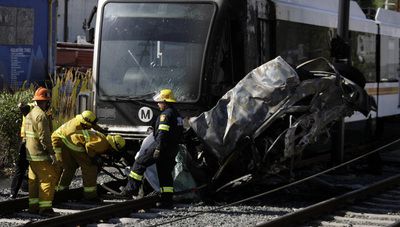(In this Sept. 21, 2007 file photo, Los Angeles firefighters survey the scene of an accident between a commuter train and an SUV in the Highland Park area of Los Angeles. Most railways offer counseling to engineers who have already literally stared death in the face, as well as to those who can be nearly certain it’ll happen to them one day. Psychologists liken the memories, the distress, the sense of isolation, the nagging fear that a deadly event may occur at any moment to the post-traumatic stress syndrome associated with soldiers returning from war. (AP Photo/Nick Ut, File))
A story out of Chicago by the Associated Press is unrelated to another light-rail accident in Minneapolis in which one person was killed, but it sheds some compelling light on the often-innocent victims of accidents: the train engineers.
What makes the deaths so traumatic is how personal they can be, with engineers often seeing the expression on a person’s face before impact. Details can be etched in their minds. Lough remembers the man he hit in 1992 who wore a black jacket, his hands in his pockets.
Bodies are typically torn apart, so the unshakable memories include gruesome scenes of the aftermath. Shoes often remain in the exact spot where people were struck because the impact lifts them of their footwear.
“You often know where they were standing by where their shoes are,” said 55-year-old Gordon Bowe, who, as a Metra conductor, is responsible for walking back to survey the carnage after an impact.
People who want to kill themselves find trains to be an effective way of doing it. In Chicago, the engineers even have a term for it — Metracide. Said one engineer:
‘This is a coward’s way to die,”‘ she thought after her train screeched to a halt. “‘You don’t want to do it, you want me to do it — you want me to end your life.’ But after the anger, there’s remorse.”
Seven people have been killed on the Minneapolis light-rail system since it opened in 2004. More than 800 people were killed by trains in the U.S. last year.

